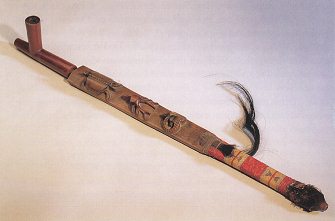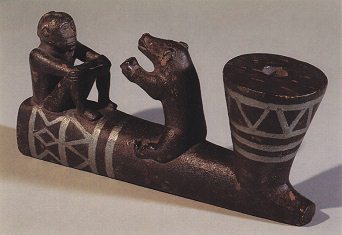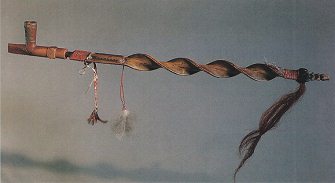North "American" Primary Nations Museum (North America Native Museum) Zurich
14. Tobacco smoking and tobacco pipes
Tobacco pipe and tobacco tamper of Sioux primary nation (photo 3)
Pipe tomahawks (photo 6)
presented and translated by Michael Palomino (2012)
| Share: |
Facebook |
|
Twitter
|
|
|
|
from:
Prestel museum guide, text by Denise Daenzer and Tina Wodiunig: Native Museum of Zurich (orig. German: Indianermuseum Zürich / Indianermuseum der Stadt Zürich); Prestel edition; Munich, New York 1996; supported by Cassinelli Vogel foundation, Zurich, by MIGROS percent for culture, by Volkart foundation in Winterthur; ISBN 3-7913-1635-4
[Important note: natives smoked "smoking herbs" - today's tobacco with resins and chemistry is very toxic
Natives smoked a mixture of herbs. They smoked the pipe only open air during ceremonies, and each person only smoked a little moment. In the smoked herb mixture there were NO resins and NO chemical substances. Add to this the natives NEVER smoked in an inner room of a tent or in a cave, but the ceremonies always took place open air, so there was hardly any passive smoking. So, when smokers of today's times with their "modern" cigarettes and with their "modern" pipe tobacco are affirming that smoking would be safe because natives also had smoked, this is a great nonsense and these persons have no idea of the details. In the cigarettes and in the pipe tobacco of today are also addictive drugs and other substances provoking a deliberate addiction to tobacco].
<Tobacco pipes
[Who was the first smoker, natives or white imperialists?]
Origin and development of tobacco plant is in the darkness yet, and there is no solution if tobacco smoking is a native invention or was brought from Europe to America. There is only for sure that the today's famous tobacco of Virginia of John Rolfe - British husband of Pocahontas - was introduced in North America. tobacco seeds were brought from the Spanish tobacco plantations in Central America and in Caribbean. With these seeds he began planting tobacco in a big style in Virginia in 1612. Basically is assumed that tobacco was won at different places and was cultivated at different times on the world.
[The first "smoke tubes" - natives need smoke for medical treatments]
In 1540 is the first time that a smoke tube is mentioned by a European. This smoke tube is of cane, and there is the indication that natives at Colorado river were provoking smelling smoke by these tubes using this smoke for medical treatments. Later also smoke tubes of wood, of slate stone, of bones, of hard coal, of ceramics, of soapstone, of sandstone and of quartz stone were found, and of more materials like non-ferrous metals. Metal tubes were made of natives in copper areas. The eldest objects have got pipe and bowl mostly in one peace. But many times there are also separated tube and mouth peaces - these are in a certain way the basic forms of the latter tobacco pipe.
[Clay bowl + cane = pipe]
All what seems to be useful for burning the "smoke herbs" was used as material. Therefore the natives in regions with no forests formed bowls of clay and put in a cane at the side as a pipe tube.
["Earth smoking" using "earth pipes" in an earth hole]
Also "earth smoking" was known, but not so spread like in South Africa, in Central Asia or in Western Asia or in Northern India. Above all nomads natives who wanted to smoke on their trips were installing their special locations digging little earth holes, covering them and putting a cane in there. Around the hole the earth was pressed well and by this the cane was converted into a pipe tube. These smoke holes were installed at some height mainly in projections so it was not necessary to come down with the body for smoking. This elementary form of smoking was also applied during the two world wars yet in the trenches.
[Smoking of "holy pipe" during important actions like festivities, contract conclusions, war declarations, or for calming down spirits]
Tobacco pipes of Sioux primary nation
The upper part of the pipe has got quillwork which is framed by glued feathers of a wild duck and at one end also by horse hair. The pipe bowl is made in catlinite. The tobacco tamper is made of root wood and has got a little bag for amulets on which are hanging two long leather straps with beading work and with four platen rattles each.
This pipe is made with reliefs of a turtle and of a head of a stag, and there is also a curved mountain sheep. The mouth peace is in catlinite. Before the mouth peace is a little quillwork part and with horse hair ornaments.
Smoking the "holy pipe" is a characteristic symbol of life and belief of the natives, and this scenery got famous and feared in Europe. Also when the use in many native cultures had different rules and forms, smoking the "holy pipe" got to be a central pan native ceremony. With this ceremony was expressed the will to live in harmony and respect with natural forces to which the humans, the animals and the plants (p.75) thank their existence with equal rights. At the same time the burning pipe is also a note of thanks to the higher power: The smoke going up is taking the prayer to the spiritual world.
So, smoking the holy pipe also is the symbol for the connection between men and to the creative force, to Earth, to the fellow men, and to the plants and animals. Holy pipe was smoked during special events - for example during familiar festivities, social rituals, contract conclusions or war declarations. From time to time a single native was using his own ceremonial pipe or the one of his tribe calming down the spirits of a chosen animal or driving out demons of an illness. IN former times the pipe also was smoked from members who made peace - and therefore the holy pipe was called "peace pipe" by the Europeans. Holy pipe is smoked today yet when natives are asking for supernatural powers, can be for the healing of an ill person, or for the support of an important action or decision.
[Symbolism: pipe bowl represents Earth and is like an altar offering plant beings on it - the ritual with pipe smoke in all directions]
This pipe bowl is of dark catlinite and has got a human and a bear's figurine. The original of this pipe bowl can be found in Lime Tree Museum in Stuttgart [South Germany].
Pipe bowl is a symbol for Earth symbolizing an altar with plant beings on it as an offering burnt for the gods. The animal is represented by feathers and fur peaces which are fixed at the pipe. First the smoke is blown to Sun and to the sky - the sky is rated as the most powerful power. The second smoke is blown town to the ground as a sacrifice for Mother Earth and it's capacities giving life. Then the smoke is blown to the east where Sun is rising every morning bringing new light. Next smoke sacrifice is blown to the west where Sun is going down - a symbol also for the death. And the fifth smoke sacrifice is blown to the north calming down the winter. The smoke of the last blow at the end is blown to the south, the location of growing and fulfillment.
This pipe consists of two small rods with a furrow all along them. After gluing all was heated over hot steam and then it was formed in the spiral way. The mouth peace has got the shape of a rattlesnake rattle. The pipe bowl is of catlinite (pipe stone) and has got tin inlays.
[Composition of "native tobacco"]
"Native tobacco" which was used by the natives in former times is also known as "kinnikkinnick" - a word of Algonkin culture which can be from Ojibwa or from Plains Cree language meaning "the mixed". This mixture did not consist - as many are speculating - of plants which are making high, but this mixture consisted of tobacco, of leaves of sumac and bearberry and of little peaces of bark of different trees like willows and alder. The composition varied depending on the plants of the region.
This tobacco bag consists in raw leather with rich ornaments made of leather straps, down feathers, beading work with stair's design and with quillwork with wrapped leather straps.
[Tobacco pipe production - pipe stone quarry with catlinite near the location of "Pipestone"]
Pipe bowls of Plains and Prairie natives mostly were made of catlinite stone, a fine-grained aluminum silicate which has got a reddish color by ferric oxide. After breaking off this stone can be cut and ornamented easily. The material comes from holy pipestone quarry in South West of Minnesota. George Catlin gave the name to this catlinite stone. He was the first white describing well this quarry in 1837. Whereas this quarry was not the only location for winning this pipe stone it was this quarry which got to be a holy site which is regularly visited and worshiped by most of native tribes. During the pilgrimages and in the quarry there was an absolute order for peace also for the tribes who were making war against each other. Also women and children could be members of the far lasting pilgrimages which were executed walking - but women and children were allowed only to the camp in Pipestone, because (p.76) the access to the holy quarry was not allowed for them.
In this camp also a leader for the holy site was elected, and as an exception this was not a person with special war qualities and did not need having rewards for war or brave actions, but this person had to have the qualities of benevolence and justice. The stay of the man lasted about two months in the quarry, and sometimes 5,000 members of the most different tribes could be occupied there. Since Mr. Catlin died Pipestone hardly has changed and today is under statal protection. Today yet natives of different tribes are working in this quarry winning this holy pipe stone. They get the permission from the Yankton [a Sioux group]. American government had given the surveillance over the holy quarry to them in 1858.
[The combination of a pipe with a tomahawk]
It's not precisely known when the combination of the peace symbol of a native pipe was combined with the war symbol of a tomahawk (photo 6). But one can admit that this was only possible after the European had sold axes and other metal tools to the natives.
Above: pipe tomahawk of Huron primary nation. On the blade made of bronze can be seen the lily emblem of the French king. Such pipe tomahawks were given from colonial authorities to important natives as a gift.
Middle: English pipe tomahawk of Seneca primary nation. Seneca natives were fighting on the English side against the army of George Washington. According to the inscription this pipe tomahawk was a pray in the decisive battle near Yorktown at 19 October 1781.
Low: pipe tomahawk, eventually of Sioux primary nation. The blade and the pipe bowl are of steel, the wooden handle is wrapped with brass wire. The shaft is in leather building a loop and with quillwork and with fringe ornaments.
[Calumet - an ornamented smoke pipe above all for ceremonies]
Another special form of tobacco pipe is calumet. This word has got an European origin deriving the French word "chalumeau" with the meaning of shawm or reed. Calumet serves many times also as a pipe, but above all it was a painted rod without pipe bowl with a special fan of eagle and owl feathers used for ceremonies. First the calumets were used always as a pair and symbolized - for example in Pawnee and other Sioux populations - the sexual dualism. More to the East of Mississippi this motive was converted into a dualism of war and peace, or also day and night, or sun and moon, south and north. Normally smoking the calumet went on with a ceremony calling to the forces of universe mediating quarrels and making peace and friendship between the populations and tribes (p.77).
^




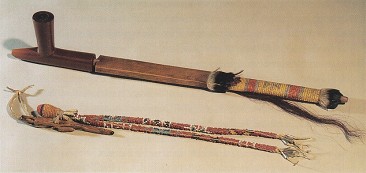
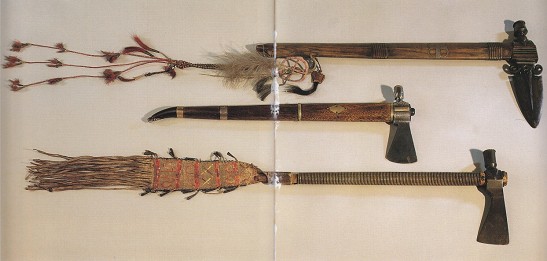
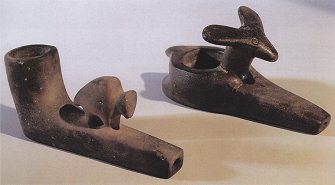
 Models
of clay tobacco pipe bowls with animal figurines
on them, from Mound primary nation (photo 2)
Models
of clay tobacco pipe bowls with animal figurines
on them, from Mound primary nation (photo 2)